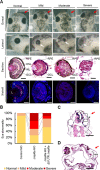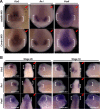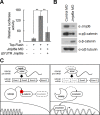Jmjd6a regulates GSK3β RNA splicing in Xenopus laevis eye development
- PMID: 31361752
- PMCID: PMC6667200
- DOI: 10.1371/journal.pone.0219800
Jmjd6a regulates GSK3β RNA splicing in Xenopus laevis eye development
Abstract
It has been suggested that Jmjd6 plays an important role in gene regulation through its demethylation or hydroxylation activity on histone and transcription factors. In addition, Jmjd6 has been shown to regulate RNA splicing by interaction with splicing factors. In this study, we demonstrated that Jmjd6a is expressed in developing Xenopus laevis eye during optic vesicle formation and retinal layer differentiation stages. Knockdown of Jmjd6a by an antisense morpholino resulted in eye malformation including a deformed retinal layer and no lens formation. We further found down-regulation of gene expression related to eye development such as Rx1, Otx2, and Pax6 in Jmjd6a morpholino injected embryos. Jmjd6 interacts with splicing factor U2AF25 and GSK3β RNA in the anterior region of Xenopus embryos. Knockdown of Jmjd6a led to deletion of GSK3β RNA exon 1 and 2, which resulted in generation of N'-terminal truncated GSK3β protein. This event further caused decreased phosphorylation of β-catenin and subsequently increased β-catenin stability. Therefore, our result may suggest that Jmjd6a plays an important role in Xenopus eye development through regulation of GSK3β RNA splicing and canonical Wnt/β-catenin signaling.
Conflict of interest statement
The authors have declared that no competing interests exist.
Figures






Similar articles
-
Kdm2a/b Lysine Demethylases Regulate Canonical Wnt Signaling by Modulating the Stability of Nuclear β-Catenin.Dev Cell. 2015 Jun 22;33(6):660-74. doi: 10.1016/j.devcel.2015.04.006. Epub 2015 May 21. Dev Cell. 2015. PMID: 26004508
-
Psf2 plays important roles in normal eye development in Xenopus laevis.Mol Vis. 2008 May 19;14:906-21. Mol Vis. 2008. PMID: 18509549 Free PMC article.
-
The Xenopus Tgfbi is required for embryogenesis through regulation of canonical Wnt signalling.Dev Biol. 2013 Jul 1;379(1):16-27. doi: 10.1016/j.ydbio.2012.11.010. Epub 2012 Dec 13. Dev Biol. 2013. PMID: 23246513
-
Kdm7a expression is spatiotemporally regulated in developing Xenopus laevis embryos, and its overexpression influences late retinal development.Dev Dyn. 2024 May;253(5):508-518. doi: 10.1002/dvdy.670. Epub 2023 Nov 1. Dev Dyn. 2024. PMID: 37909656 Review.
-
Morpholinos Do Not Elicit an Innate Immune Response during Early Xenopus Embryogenesis.Dev Cell. 2019 May 20;49(4):643-650.e3. doi: 10.1016/j.devcel.2019.04.019. Dev Cell. 2019. PMID: 31112700 Free PMC article. Review.
Cited by
-
Case report: A novel intronic JMJD6 likely pathogenic variant (c.941+75G > T) associated with congenital eyelid coloboma in one of the identical twin sisters.Front Genet. 2025 Feb 17;16:1536000. doi: 10.3389/fgene.2025.1536000. eCollection 2025. Front Genet. 2025. PMID: 40034743 Free PMC article.
References
Publication types
MeSH terms
Substances
LinkOut - more resources
Full Text Sources
Medical

